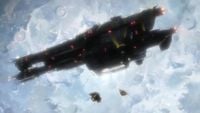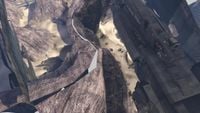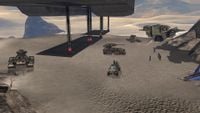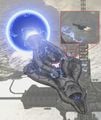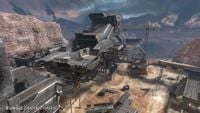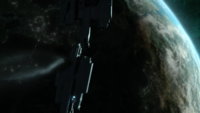UNSC frigate: Difference between revisions
From Halopedia, the Halo wiki
(heavy frigate established to be a sub-class; modified page accordingly.) |
(→Layout) |
||
| Line 47: | Line 47: | ||
==Layout== | ==Layout== | ||
The [[bridge]] of the frigate is located in the uppermost part of the ship, in the section at the stern-most tip of the MAC gun shaft (in the case of the only seen version of the UNSC frigate, there is another layout variation similar in appearance to the [[Halcyon-class Cruiser]], ''{{UNSCship|Pillar of Autumn}}''. The commanding officer's chair is located behind the two primary consoles within the bridge. There are numerous other consoles located at the sides of the room. There are four bridge stations: Navigation, Operations, Weapons, and Communications. | The [[bridge]] of the frigate is located in the uppermost part of the ship, in the section at the stern-most tip of the MAC gun shaft (in the case of the only seen version of the UNSC frigate, there is another layout variation similar in appearance to the [[Halcyon-class Cruiser]], ''{{UNSCship|Pillar of Autumn}}''). The commanding officer's chair is located behind the two primary consoles within the bridge. There are numerous other consoles located at the sides of the room. There are four bridge stations: Navigation, Operations, Weapons, and Communications. | ||
A UNSC Frigate also possess 12 [[Single Occupant Exoatmospheric Insertion Vehicle|SOEIV]] bays, located in the rear of the ship, which facilitate the deployment of [[Orbital Drop Shock Trooper]]s. | A UNSC Frigate also possess 12 [[Single Occupant Exoatmospheric Insertion Vehicle|SOEIV]] bays, located in the rear of the ship, which facilitate the deployment of [[Orbital Drop Shock Trooper]]s. | ||
Revision as of 12:34, December 10, 2010
| This article does not meet the wiki's general standards and/or standards on layouts. You can help by cleaning this article. |
Frigate is a warship classification in the UNSC Navy, with the Hull Classification Symbol of FFG. Although it significantly lacks the amount of armor, armament, and firepower compared to its larger cousin, the UNSC Destroyer, the frigate is lighter and thus more maneuverable. It is also cheaper to produce, allowing greater numbers to be fielded against the Covenant.
Background
With current human technology, UNSC frigates are barely considered a match for even the smallest of Covenant warships. It is outclassed even by smaller Covenant ships, its armor is susceptible to enemy point-defense pulse lasers and plasma torpedoes, and it is outfitted with substandard weaponry. Only en masse does the UNSC frigate give any UNSC fleet element an advantage against even inferior numbers of Covenant Capital Ships.
There are a number of different variants of the UNSC frigate; two named ones being the light frigate and heavy frigate.
Layout
The bridge of the frigate is located in the uppermost part of the ship, in the section at the stern-most tip of the MAC gun shaft (in the case of the only seen version of the UNSC frigate, there is another layout variation similar in appearance to the Halcyon-class Cruiser, Template:UNSCship). The commanding officer's chair is located behind the two primary consoles within the bridge. There are numerous other consoles located at the sides of the room. There are four bridge stations: Navigation, Operations, Weapons, and Communications.
A UNSC Frigate also possess 12 SOEIV bays, located in the rear of the ship, which facilitate the deployment of Orbital Drop Shock Troopers.
They also have either a garage or cargo bay in their rear section which is capable of extending out of the ship's ventral side to deploy vehicles or cargo directly to the ground.[1][2] The Template:UNSCship carried three Pelican dropships in this rear section in addition to several ground vehicles.
Specifications
Dimensions
A typical frigate of 2552 appears to be around 478 metres (1,570 ft) long, 151 metres (500 ft) wide and 112 metres (370 ft) tall. It is one of the smallest warships fielded by the UNSC.
Propulsion
Like other human ships, the UNSC Frigate is powered by thermonuclear fusion reactors which use deuterium (a stable hydrogen isotope) as fuel. The engines almost certainly use the energy obtained from this process to heat some form of reaction propellant which is expelled out of rear-facing exhausts to generate thrust. There are four exhausts visible on frigates; two large and two small.
UNSC Frigates are capable of hovering in an atmosphere and even landing. This is likely accomplished through the use of anti-gravity generators, although the technology involved has never been elaborated upon.
For interstellar voyages, the Frigate carries a Shaw-Fujikawa Translight Engine.
Armament
A typical UNSC frigate carries the following armament:
- 1 Magnetic Accelerator Cannon which is able to fire one round per charge. The MAC runs between one- and two-thirds of a Frigate's total length.
- 3 Shiva-class Nuclear Missiles serve as heavy ordnance.
- 40 Archer missile pods which carry around thirty missiles per pod, adding up to a total of 1200 missiles.
- 12 50mm point defense guns function as the last line of defense against single ships and incoming missiles, with the ability to later retract into the vessel.
Crew
No precise figures are available regarding the crew of a frigate, but it is likely relatively small, (less than a hundred would be stationed on a frigate). Like larger ships, a detachment of Marines and sometimes ODSTs would be present onboard. The crew number includes deck crews as well as the command crew, Marines, ODSTs, dropship pilots, and technical personnel. The number of personnel a single frigate is capable of housing numbers at least within the thousands.[3][verification needed]
In 2552 Sergeant Major Avery Johnson was supposedly able to single-handedly control the frigate Template:UNSCship to aid SPARTAN John-117 and Arbiter Thel 'Vadam on the newly rebuilt Halo, though this was likely performed using an auto-pilot function. An AI can monitor and regulate all critical functions without human intervention.
Superstructure
The armor of a frigate is relatively poor compared to that of its larger cousins and counterparts such as the destroyer, with only 60cm of Titanium-A battle plate. However, due to its relatively light weight, the frigate's strength lies instead in maneuverability and speed. The frigate's relatively wide design is supported by structural support ribs, allowing it to perform orbital incursions. [4]
Known Frigates
Gallery
- InAmberClad-scale.gif
A scale comparison between the UNSC frigate and miscellaneous objects.
A UNSC frigate picking up survivors from Algolis.
- ArabiaVostok.png
UNSC Arabia and UNSC Vostok being destroyed at the First Battle of Harvest.
As shown here, Longsword fighters are not too large to be carried by frigates.
- 10203554-Full.jpg
The underside of a typical UNSC frigate.
A frigate firing a round from its Magnetic Accelerator Cannon.
UNSC frigate In Amber Clad compared to the Prophet of Regret's assault carrier.
A UNSC frigate, the Commonwealth, being taken apart, partially showing the ship's internal structure.
A destroyed UNSC frigate over Reach from announcement trailer.


